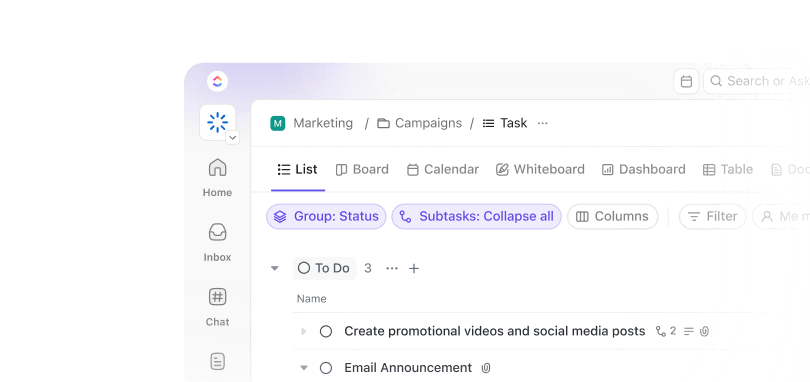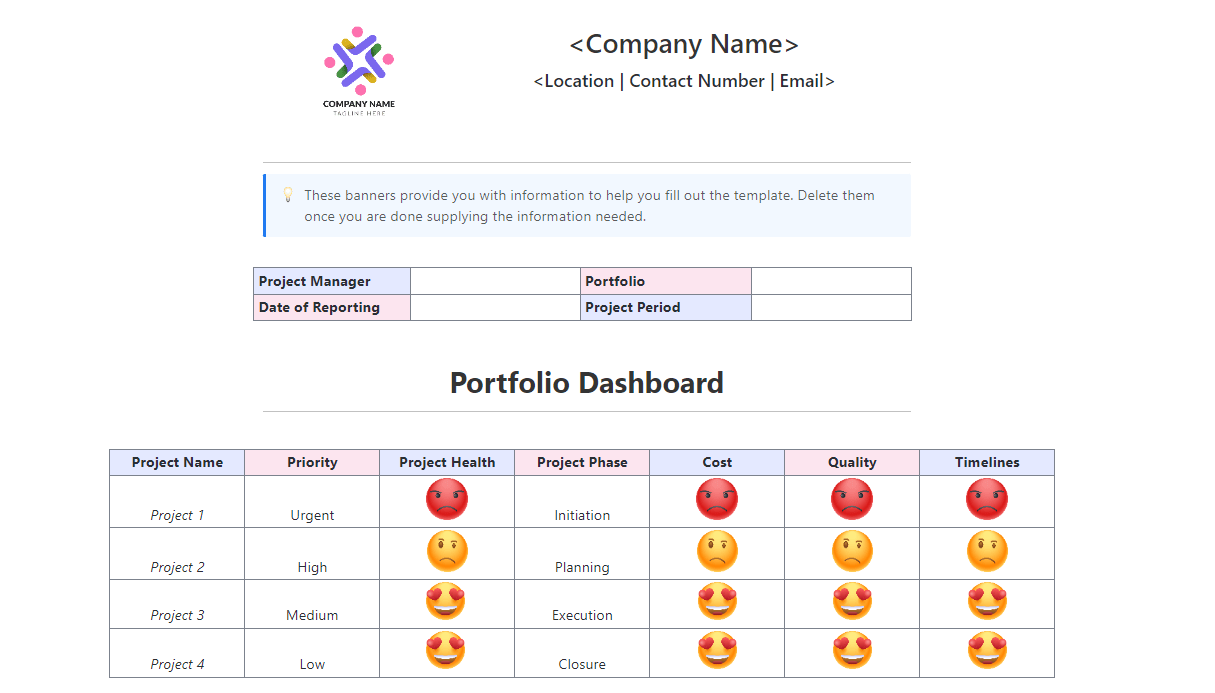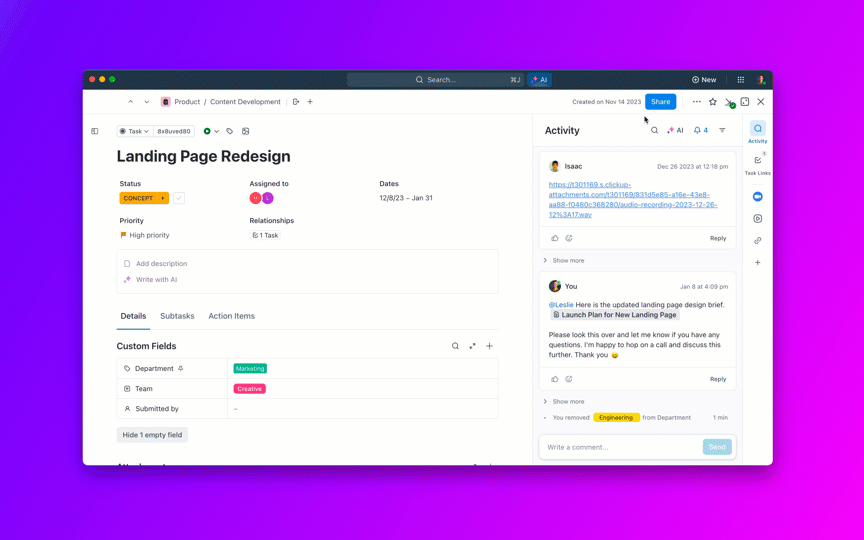Your marketing team generated 100 high-potential leads, but three weeks later, the sales team has only reached out to 5. What happened to the other 95?
Most likely, they’ve slipped through the cracks of the “handoff gap”—the space where qualified leads go missing between marketing and sales, often resulting in missed revenue opportunities.
This isn’t just a big company problem. Businesses of all sizes struggle with it. Marketing does its job attracting potential buyers, but without a clear handoff process, these leads either get delayed follow-up or vanish entirely.
The solution? A well-structured marketing-to-sales handoff process.
In this guide, I’ll walk you through what makes handoffs work, the pitfalls to watch for, and practical steps to create a process that actually drives revenue.
We’ll also look at how tools like can help streamline the handoff and keep both teams aligned.
Marketing to Sales Handoff: Definition, Process, and Best Practices
What Is a Marketing to Sales Handoff?
At its core, the marketing-to-sales handoff is when your marketing team passes qualified leads over to sales. This happens once a lead shows enough interest or engagement, for example, maybe they’ve downloaded your ebook or spent time checking out your pricing page.
The whole point of this marketing and sales strategy is to ensure that good leads reach your sales team at just the right moment, with all the necessary background information. This way, your sales reps can pick up the conversation naturally, without awkward gaps or having to ask questions the lead has already answered elsewhere.
In the bigger picture of your customer journey, this handoff sits right between lead generation and direct sales conversations.
The marketing department works to attract and nurture potential customers, while the sales department takes those warmed-up leads and guides them toward becoming paying customers.
A solid handoff process needs to cover:
- Information transfer: The essential data moving from marketing to sales (contact details, company info, how they found you, what they’ve done on your site)
- Qualification criteria: The specific rules that tell you when a lead is sales-ready (company size, decision-maker status, level of engagement)
- Timing: When exactly the handoff happens (too soon and you waste sales resources; too late and the lead goes cold)
- Team responsibilities: Who handles what part of the process (marketing team qualifies, sales follows up within a set timeframe)
Why Does the Marketing to Sales Handoff Process Matter?
A smooth marketing-to-sales handoff has a direct impact on your bottom line and the effectiveness of your teams working together. When marketing and sales are in sync, you’ll see it reflected in your sales pipeline.
🔎 The numbers don’t lie: According to a HubSpot report, Sales professionals at companies with aligned sales and marketing teams are 103% more likely to beat their goals than sales professionals at companies that aren’t aligned.
This handoff process touches several critical areas of your business:
- Conversion rates: Properly qualified leads are far more likely to become customers
- Customer experience: Quick, relevant follow-up makes prospects feel valued and understood
- Team efficiency: Clear processes mean less duplicate work and fewer miscommunications
Here’s what the difference looks like in practice:
| Aspect |
Poor Handoff Process |
Optimized Handoff Process |
|
Lead response time |
Delayed (24+ hours) |
Immediate (within hours) |
|
Lead context |
Minimal data shared |
Complete profile and engagement history |
|
Conversion rates |
Below industry average |
Meets or exceeds benchmarks |
|
Team alignment |
Siloed, often conflicting |
Collaborative, shared goals |
Key Roles in the Handoff Process
A successful marketing to sales handoff involves several teams working in concert. Each plays a specific part in moving leads through the customer journey.
Marketing team responsibilities
Your marketing team’s job is to generate and nurture leads until they’re ripe for sales (and lead management software can be a boon here!). Their main responsibilities include:
- Scoring leads based on how they engage with your content and marketing campaigns
- Building out lead profiles with relevant data (job titles, company size, etc.)
- Keeping track of how leads interact with you (which pages they visit, which emails they open)
- Passing complete lead information over to sales
Sales team responsibilities
Once leads are handed over, your sales team takes the baton. Their key tasks include:
- Evaluating if leads are a good fit for what you’re selling
- Giving marketing honest feedback about lead quality
- Following up within the timeframes you’ve agreed on
- Keeping lead status updated in your systems
💡 Pro Tip: Build a shared pipeline in CRM where sales can track lead status, leave feedback for marketing, and get auto-reminders for follow-ups.
Use Custom Fields to qualify leads, assign them to reps, and flag anything that needs a second look. It’s like a no-fluff CRM that keeps your team fast, focused, and in sync.
Explore how helps sales teams!
Revenue operations (RevOps) responsibilities
Your RevOps team is the backbone of the whole operation. They manage the systems and workflows that make handoffs possible – designing processes, setting up tools, keeping data clean, and creating reports that help everyone improve.
How To Define a Good Handoff between Marketing and Sales?
Knowing when a lead is ready to move from marketing to the sales team isn’t guesswork. It’s a decision based on their behavior, characteristics, and how interested they seem to be.
Qualification stages
Most companies use a staged approach to lead qualification:
- Marketing Qualified Lead (MQL): This is someone who’s engaged with your marketing content and meets your basic criteria. Think of someone who downloads your industry report and works at a company in your target market
- Sales Accepted Lead (SAL): This is a lead your sales team has looked at and agreed is worth pursuing. It’s like a checkpoint before investing more time
- Sales Qualified Lead (SQL): Now we’re talking about someone sales has verified meets your standards for a real sales conversation. This might be a person who’s requested a demo or mentioned they have a budget set aside
Lead scoring models
Lead scoring is just a way to assign points to leads based on what they do and who they are. More points usually mean they’re closer to buying. For instance:
- Checking out your pricing page: +10 points
- Downloading a case study: +5 points
- Having a job title like “Director” or higher: +15 points
- Working at a company with 500+ employees: +10 points
Once someone hits your threshold (say, 50 points), they’re ready to be handed to sales.
Key qualification signals
Several types of signals help you spot qualified leads:
- Engagement signals: How they interact with you – website visits, content downloads, email opens, showing up to your webinars
- Intent signals: Actions that show they’re considering a purchase – visiting your pricing page, requesting demos, comparing your product to competitors
- Fit criteria: How well they match your ideal customer – company size, industry, tech they already use, signs they have the budget
💡 Pro Tip: A common reason marketing-to-sales handoffs break down is that the process isn’t clearly documented, or when teams use different versions of it.
To avoid confusion, try using a company process documentation template for your sales to marketing handoff process. 👇🏼
It gives you a structured space to:
- Outline each step in the handoff
- Define what information marketing should pass to sales
- Clarify team roles and expectations
- Link out to lead scoring guidelines, CRM fields, or contact owners
Having everything in one place makes it easier for both teams to stay aligned and refer back to the process when needed, especially as things evolve.
How to Improve Your Marketing to Sales Handoff Process?
Creating an effective marketing to sales handoff isn’t rocket science, but it does require a thoughtful approach. Here are the key steps to build a system that works.
1. Define clear MQL and SAL criteria
First things first – you need to spell out exactly what makes a lead qualified. For Marketing Qualified Leads, be specific about the engagement and fit criteria marketing will use. For example:
- They’ve downloaded at least two of your resources
- They’ve visited your website three or more times in the last month
- They work at a company with at least 100 employees
- Their job title includes words like “Manager,” “Director,” or “VP”
For SALs, define what sales will look for when deciding to accept leads. This might include:
- Some indication they have a budget for your solution
- Signs they have decision-making power
- A clear need they’re trying to solve now, not someday
- A good match with your target customer profile
✅ How helps:
Using custom fields in the List View, you can tag leads with their qualification status and create custom statuses to track their progression through your pipeline.
Set up Docs to house your qualification criteria with detailed descriptions, examples, and threshold definitions that both teams can reference. You can use Brain to help with the documentation.


Not only that: with ’s robust permission settings, you can ensure marketing and sales have appropriate access to collaborate on these documents, leaving comments and suggestions to refine criteria over time.
This ensures both teams are working from the same qualification framework without constant meetings or manual updates.
🎥 Bonus: Watch how AI can help streamline your documentation process: 👇🏼
2. Map out your handoff workflow
Create a visual workflow showing each step in the handoff process. This should include:
- When and how leads are scored
- Who reviews leads before handoff
- How leads are assigned to sales reps
- Expected response times
- What happens if a salesperson rejects a lead
Make sure to assign responsibility for each stage and set clear time expectations. To speed things up, try roles and responsibility templates to determine who needs to do what.
✅ How helps:
With the Whiteboards feature, you can collaboratively map this workflow visually, allowing both marketing and sales teams to contribute in real time.
Use ’s Custom Statuses in your tasks to track where each lead stands in your handoff process, such as MQL, SQL, Discovery, or Demo, and set up automations to move leads between stages when specific criteria are met.


3. Centralize data in one system
Using a unified CRM or platform keeps everyone on the same page. This central system should:
- Store all lead information
- Track engagement history
- Show qualification status
- Allow both teams to update information
✅ How helps:
can act as your single source of truth by centralizing sales and marketing data within a customizable workspace.
Using CRM templates or custom-built views, teams can store complete lead profiles, including contact details, qualification scores, campaign history, and notes,without needing to jump between tools.
With Forms, marketing teams can collect lead details directly into the workspace, ensuring consistency and reducing manual entry.


Every form submission becomes a task that can be tagged, scored, and routed automatically using automations.
4. Automate notifications and tasks
Automation reduces delays and manual effort in the handoff process:
- Set up automatic notifications when leads qualify
- Create task assignments for sales follow-up
- Develop nurturing sequences for leads not yet ready
- Implement alerts for follow-up deadlines
✅ How helps:
’s Automation feature makes this process seamless by triggering notifications when leads reach qualification thresholds.
You can automate lead follow-ups, deal updates, and task assignments with ’s reating recurring reminders for nurturing activities, to keep your sales pipeline moving smoothly.
You can set up custom automation rules based on your specific qualification criteria, for example, automatically moving leads to “Sales Ready” status when they reach a certain score or visit high-intent pages.
These automated workflows eliminate manual handoffs while maintaining the personal touch your prospects expect.
5. Align teams with regular check-ins
Schedule regular meetings between marketing and sales teams to:
- Review key metrics and recent performance
- Address any handoff issues
- Share feedback on lead quality
- Discuss process improvements
✅ How helps:
For distributed teams, ’s AI Notetaker captures real-time meeting notes, while Brain summarizes key points and documents decisions—automatically notifying the right team members about tasks and updates.


These structured check-ins foster collaboration and enable continuous process improvement without requiring additional tools or platforms.
Common Challenges and Best Practices
Even well-designed handoff processes face challenges. Here are common issues and how to address them.
1. Misaligned goals
Marketing and sales teams often have different objectives. Marketing might focus on lead quantity, while sales prioritizes quality.
Best practice: Create shared sales goals that strike a balance between quantity and quality. For example, set targets for both the number of qualified leads and their conversion rate. Consider joint metrics like “revenue influenced” that both teams contribute to.
Goals allows teams to create shared objectives with trackable targets that both departments can view and contribute to.
Set up folders for marketing and sales KPIs while linking them to overarching revenue targets, creating transparency and alignment without additional meetings.
💡 Pro Tip: Use the SMART Goals template in to set crystal-clear, measurable objectives that both marketing and sales can align around.
Instead of vague targets, you’ll define exactly what success looks like, like “50 qualified leads per month” or “20% lead-to-close rate.”
Here’s why you’ll like this template:
- Translate big goals into focused actions using goal-specific prompts
- Track progress with measurement tools, visual indicators, and custom statuses
- Adjust timelines or targets as priorities evolve, without losing context
- Centralize goal execution within your workspace for daily visibility
2. Inconsistent data
When lead data is scattered across systems or incomplete, sales teams lack the context they need.
Best practice: Implement data standards and synchronization between platforms. Regular data cleaning helps remove duplicates and standardize formats. Create required fields for essential information to ensure completeness.
With ’s Custom Fields and required form inputs, you can standardize what information must be collected for each lead.
The platform’s integration capabilities connect with your existing marketing and sales tech stack, allowing data to flow between systems while maintaining a single source of truth for lead information.
3. Slow follow-up
Delays in contacting leads significantly reduce conversion chances. Research shows that leads contacted within 30 minutes are 7 times more likely to qualify.
Solution: Set clear service-level agreements (SLAs) for follow-up timing. Use automated reminders to notify sales when follow-up is due. Track response times to identify and address delays.
’s Time Tracking feature and deadline functionality help enforce SLAs by making response times visible to everyone.


Set up task priority flags for high-value leads and use dependencies to ensure critical follow-up tasks don’t get overlooked in busy sales environments.
Metrics for Successful Marketing Sales Handoff
To know if your handoff process works, you need to track the right metrics and manage feedback.
Track conversion rates
Monitor how leads move through each stage of your process:
- MQL to SAL conversion rate
- SAL to SQL conversion rate
- SQL to opportunity conversion rate
- Time spent in each stage
These metrics show where leads might be getting stuck or falling out of the process.
Dashboards provide real-time visualization of these critical conversion metrics. Create custom charts that display pipeline velocity and conversion rates at each stage, helping teams quickly identify bottlenecks without digging through spreadsheets.
Gather feedback
Both marketing and sales teams should provide regular input on the handoff process:
- Have sales rate lead quality
- Ask marketing if sales follow-up is timely
- Review rejected leads for patterns
- Document successful conversions
This feedback helps identify specific improvements to make.
Using Forms, create standardized feedback mechanisms where sales can quickly rate lead quality after initial contact.
Set up automations for recurring tasks for regular process reviews, with ’s assigned comments and Chat Threads keeping all feedback organized by lead type or campaign source.
Refine your approach
Use data and feedback to continuously improve your process:
- Adjust qualification criteria based on conversion rates
- Update lead scoring models as you learn what signals predict success
- Test different handoff methods to see what works best
- Balance speed and quality based on results
Small, data-driven adjustments over time lead to significant improvements.
Here, version history and documentation features can help make process iteration transparent.
Track updates to your qualification criteria and scoring models in Docs. This keeps a clear record of what changed, why it changed, and what worked best for different lead types.
From Handoff to High Conversion: Make Every Lead Count
Remember, this isn’t just a technical process; it creates a seamless customer experience that improves conversion rates.
When both teams are working from the same playbook, leads move seamlessly through your funnel, and sales get the context they need to close faster.
To make it happen:
- Align on what a qualified lead looks like
- Set clear roles, responsibilities, and timelines
- Automate alerts and task assignments to remove guesswork
- Centralize everything from lead data to feedback loops
With , you don’t have to piece this together across tools. From customizable handoff workflows to shared goals, real-time notifications, and collaborative docs, brings marketing and sales together in one place, so your leads never fall through the cracks.
Start streamlining your handoff process with . Start using for free!
FAQs about marketing to sales handoff
How does a marketing to sales handoff differ in B2B versus B2C environments?
In B2B environments, the handoff typically involves longer sales cycles with multiple decision-makers, requiring more detailed lead information and often multiple handoff points, while B2C handoffs are usually simpler with faster conversion timelines and fewer decision-makers.
What technology tools best support an effective handoff process?
The most effective handoff processes use integrated CRM systems, marketing automation platforms, and collaborative work management tools, like , that provide real-time data sharing, automated notifications, and clear visibility into lead status.
How frequently should marketing and sales teams review their handoff process?
Marketing and sales teams typically review their handoff process quarterly, with monthly check-ins on key metrics and immediate attention to any significant drops in conversion rates or increases in lead response times.
Using ’s recurring tasks and automated reports, teams can schedule these reviews and have the relevant data automatically compiled for efficient analysis.
What role does content play in supporting the marketing to sales handoff?
Content serves as both a qualification tool before handoff (by tracking engagement) and as sales enablement material after handoff, with marketing providing sales teams relevant content pieces that resonate with each lead to help personalize follow-up conversations.
Docs and Brain allow teams to organize this content library or database with engagement metrics attached, helping sales quickly identify which resources have already resonated with specific leads.


Everything you need to stay organized and get work done.














